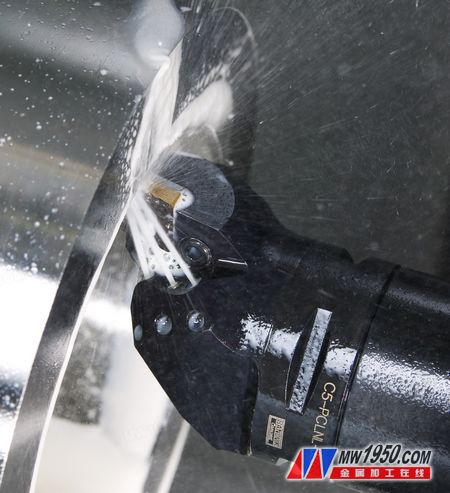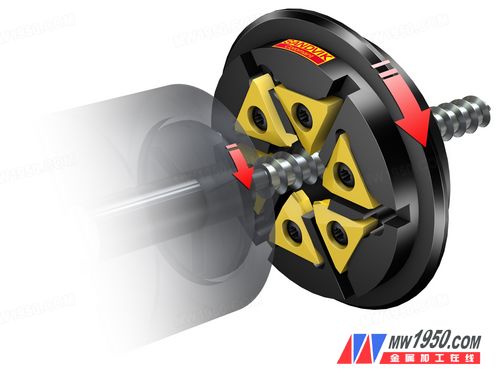Improve mature processing methods
Just as competitive pressures in the manufacturing industry, the slender screws (such as bone screws) that produce high-performance metal materials in large quantities are also increasing. This is often the case for suppliers in the medical industry, where the processing volume of such products is increasing, and threaded cyclone milling is an established processing method. The inherent stability of this process makes it ideal for high-volume production and processing of demanding metal materials. Cyclone milling allows for a more robust cutting edge, which opens up more possibilities for the introduction of new tool materials with higher wear resistance.
The benefit is that the tool life is quite long, which means shorter machine downtime during production. In addition, the edge toughness of the cutting edge is improved, making the cutting edge sharper and safer for cutting. The rational use of these technological advancements in other processing areas and the development of special indexable inserts and tools for small part cyclone milling consolidate the economic advantages of manufacturing medical parts.

The ever-increasing development of blade technology provides more room for improved cutting edges, allowing for the full benefits of threaded cyclone milling. For example, coated carbide inserts result in longer and more predictable tool life and the ability to apply higher cutting speeds. This results in higher part yields and consistent tolerances and surface finish. New blade materials (such as those with PVD/TiAlN coatings) have a unique thin coating that provides excellent adhesion to the blade substrate. This material has proven to be very advantageous for the sharp cutting edges required for thread-wound milling of various workpiece materials, such as the metal materials used for bone screws.
For thread-wound milling, operational safety and tool clamping are also critical to ensure higher processability. Tool accuracy determines blade positioning, the quality of the blade grinding, and the convenience and reliability of each time the blade is properly positioned. The newly developed blade clamping concept for threaded cyclone cutters improves the positioning accuracy and machining safety of the cutting edge and makes tool change on the machine tool easier and faster. Smooth tangential cutting is necessary to ensure the high precision and surface finish required throughout the machining process.

At present, threaded cyclone milling cutters should include specially developed precision grinding inserts and semi-finished products, and should be compatible with most types and configurations of sliding tool holder spindles. Despite the well-established process in mass production, new processing techniques are required to meet higher production and new part requirements, such as the more advanced tool ring concept in threaded cyclone milling.
In one example of a bone-wound screw-made bone screw, there is approximately 500,000 production per year, and small batches vary depending on the situation. The installation of advanced indexable insert tools not only reduces processing costs, but also greatly enhances manufacturing competitiveness. This new tool means that the tool life can be extended by a factor of eight, and more parts can be machined before the cutting edge needs to be replaced (when the part size is about to exceed the tolerance). In addition to eliminating all machine downtimes, tool room management time is greatly reduced due to easier tool maintenance.
Advanced coolant application solves the problem
Now, slitting machines with coolant supply offer new possibilities for improving small part machining. The use of high pressure cooling systems to replace conventional cutting zone coolants has many processing advantages. The introduction of such an auxiliary cutting means does not require complicated and elaborate means, since standard tools can be used, and it is common to use internal cooling. After a period of continuous research and development, high-pressure cooling processing has formed a high-level processing concept today. In the processing of materials with strict chip control requirements (such as superalloys and mild steel), the biggest advantage of this solution is improved machining performance and chip removal.
New machining concepts are now available for small part machining, allowing high pressure coolant to be injected directly into the cutting zone. This type of solution combines precise orientation of coolant spray and tool holder clamping for simple and safe features. This opens up a whole new perspective for more efficient machining of demanding materials, especially on slitting machines where small sets of tools are located in very tight spaces, and tool change and clamping are difficult and time consuming. With a tool positioning and locking function and a machine with a coolant connector, the new tool clamping system can simultaneously improve machining and tool change.
Turning tools with high pressure cooling (HPC) function typically have three nozzles that precisely deliver the coolant jet to the appropriate position on the blade. The coolant affects the distribution of heat generated in the cutting zone, the amount of tool wear, the actual form of the chip, and the degree of bonding of the workpiece material attached to the cutting edge. The coolant jet is effectively shortened by the so-called "hydraulic wedge" formed between the chip and the rake face of the insert. It has been proven that this has a major impact on tool life and chip formation. Achieving good chip control in the machine helps ensure safe unattended production as well as tolerances and surface finish levels of machined parts and thereby increase productivity.
On machines that are suitable for small part machining, it is very easy to apply a high pressure cooling system and to change the tool quickly and easily. This is achieved by clamping and loosening the shank with only one screw and a spring-loaded wedge for fixing the shank in the tool holder. Accurate and safe cutting edge positioning is achieved when the tool holder is installed and replaced. In combination with the internal cooling of the shank and the simple and safe coolant connection between the shank and the seat, the long chip material that is difficult to machine without trouble-making is a common cutting method for processing small parts in the medical industry.

The tool change can be performed simply by loosening the single screw on the QS-HP quick-change tool holder, which usually reduces the tool change time by more than 2/3 - from 3 minutes to 1 minute. Clamping the wedge ensures safe and quick extraction of the tool and reduces the risk of tool drop during clamping. Once the tool is mounted on the machine , the cutting edge position is automatically adjusted by the contact between the short shank and the stop. When performing the forward and reverse steps, a safe cutting edge position typically reduces the tool movement by an average of 30%, thereby improving accuracy.
Recent developments in cutting tools have made the CoroMIll 325 threaded cyclone milling tool a more advantageous method of thread forming. The use of threaded cyclone milling thread is efficient, safe and accurate. The new tool concept and indexable inserts offer considerable advantages for machining small parts such as bone screws.
Turning with high-precision coolant injection has made great strides in various machining applications. This technology is now not only seen as a tool for solving problems, but also a means to truly optimize the performance of a large number of parts in the medical industry. When turning small parts, the CoroTurn QS-HP is able to apply high pressure cooling and enables fast and safe tool change.
For more information on CoroMIll 325 thread cyclone milling, please visit:
http://
Antique Bathroom Accessories
Antique Bathroom Accessories are often made of brass. Antique is a kind of style, finished by different colors. These are quite different from contemporary style, although they are also made of brass. That`s why we separate them as one class. Antique bathroom accessories are popular in American and European countries.
Antique Bathroom Accessories
Antique Bathroom Accessories,Retro Bathroom Accessories,Vintage Bathroom Accessories,Vintage Bathroom Decor
SHENZHEN KING OF SUN INDUSTRY CO.,LTD , http://www.handyfaucet.com